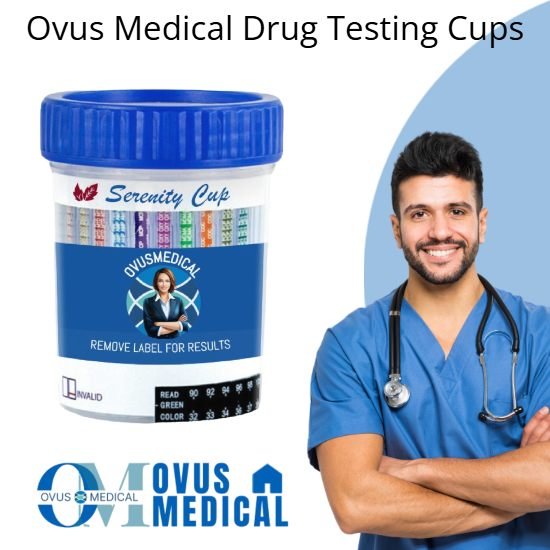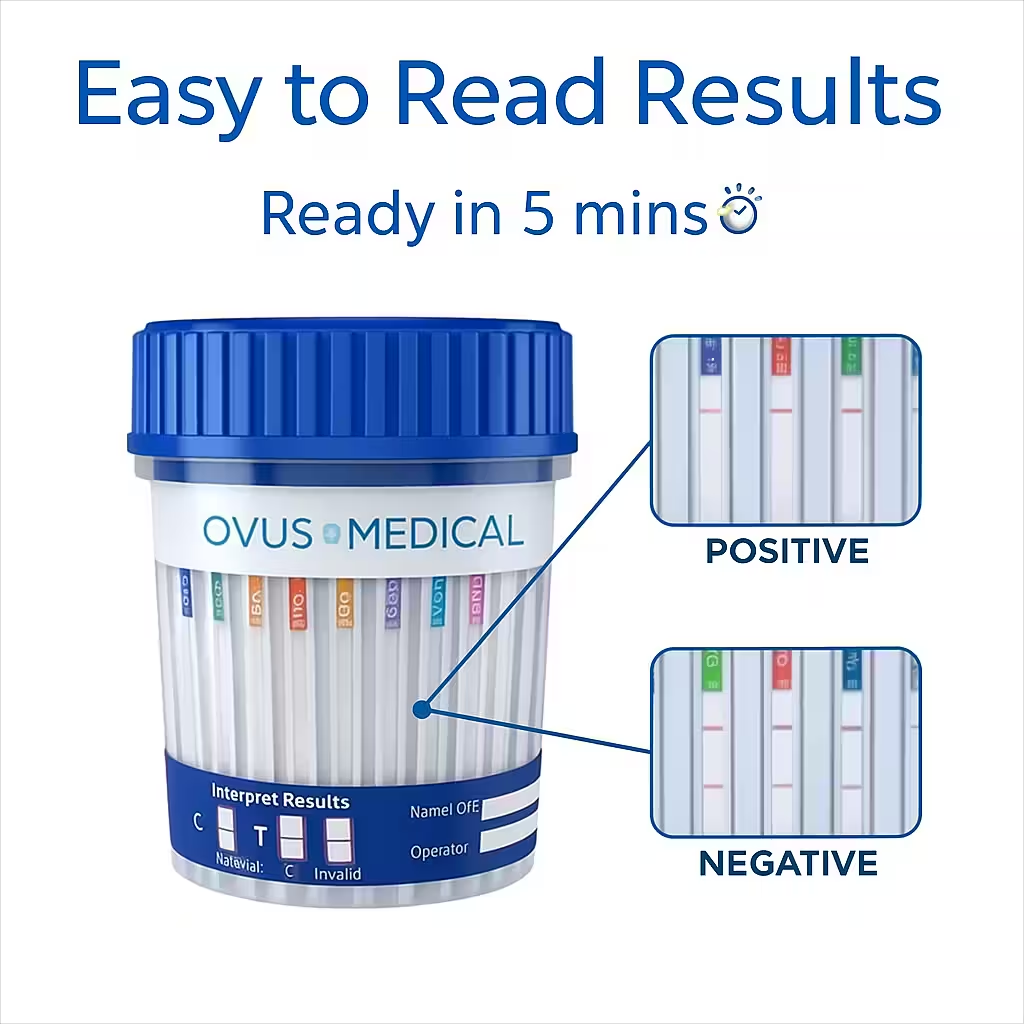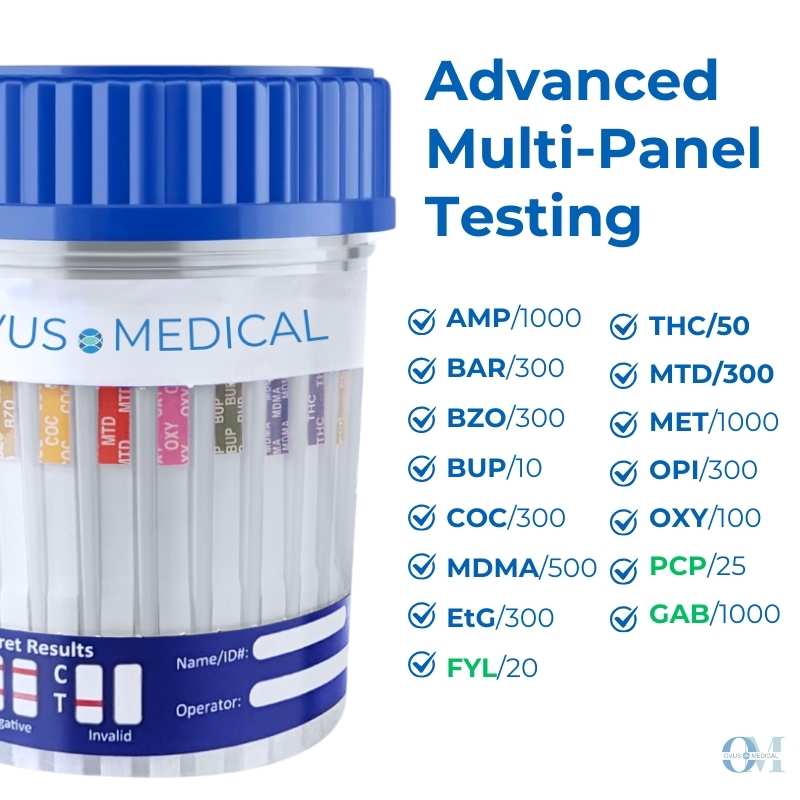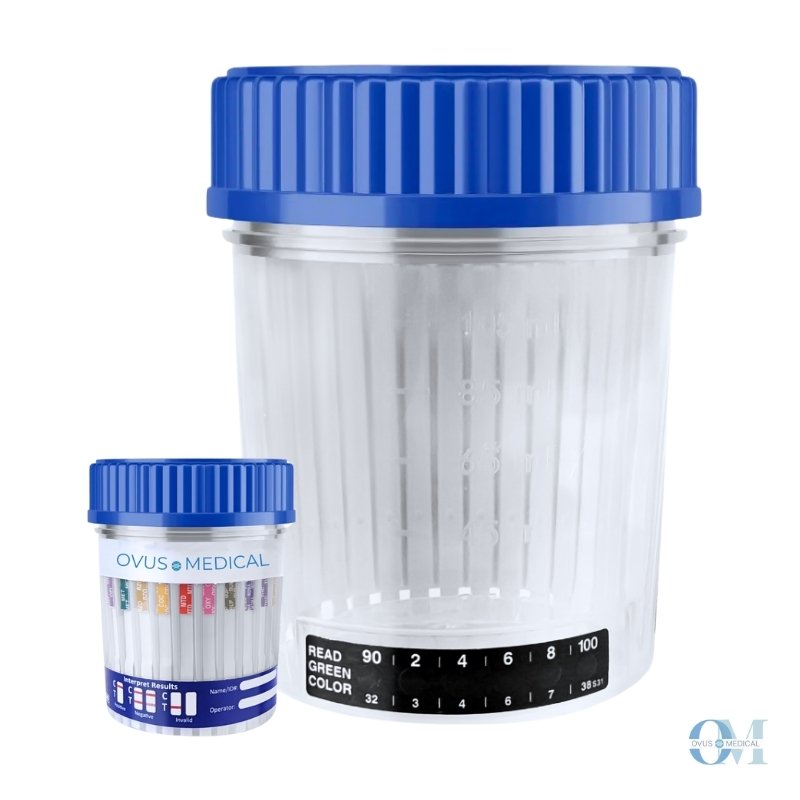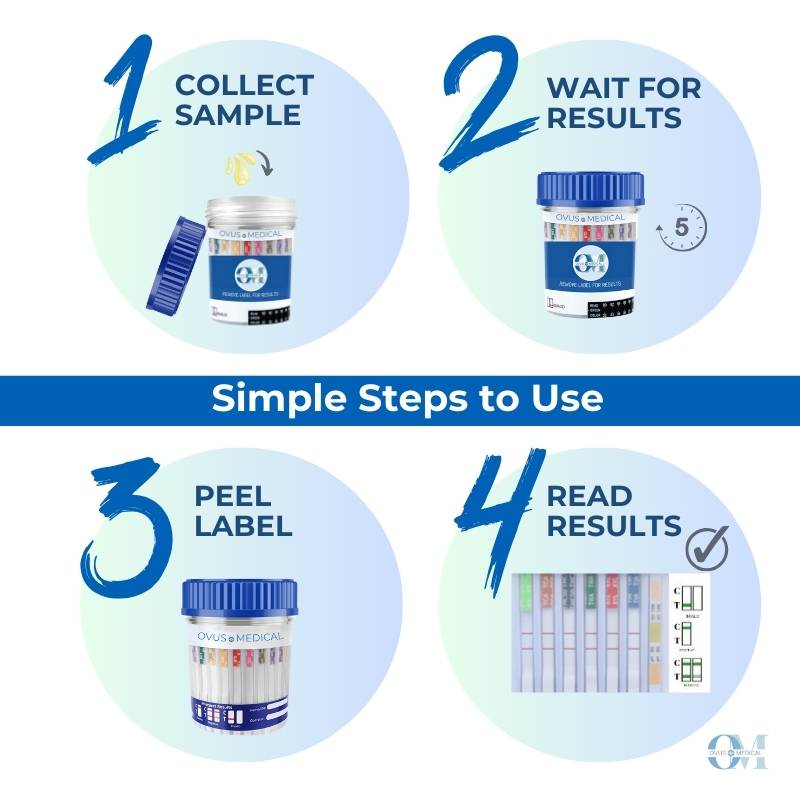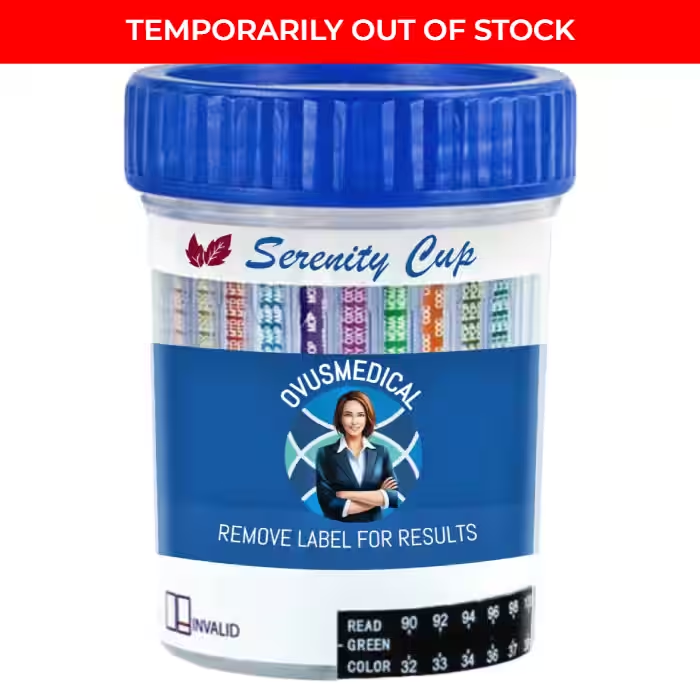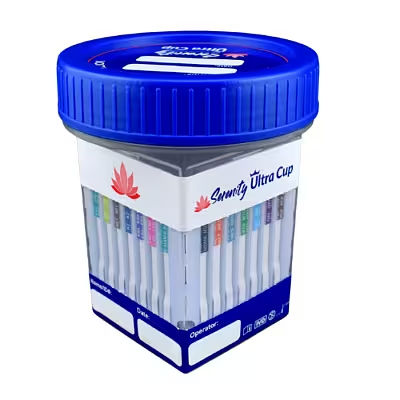15 Panel Drug Test Cup with GAB, FYL & EtG
FREE SHIPPING: Qty 100+
AS LOW AS $2.89 ea.
BULK PRICING CALL: 1-800-921-8241
Drugs Tested:
AMP/1000, OPI/300, MET/1000, BZO/300, COC/300, MTD/300, OXY/100, BUP/10, MDMA/500, THC/50, PCP/25, KRA/500, FEN/20, ETG/300
— Plus 3 Adulteration Checks: Specific Gravity, pH, and Creatinine
AMP/1000, OPI/300, MET/1000, BZO/300, COC/300, MTD/300, OXY/100, BUP/10, MDMA/500, THC/50, PCP/25, KRA/500, FEN/20, ETG/300
— Plus 3 Adulteration Checks: Specific Gravity, pH, and Creatinine
15 Panel Drug Test Cup
Why Choose the 15 Panel Drug Test Cup by Ovus Medical?
Ensure precise and dependable drug screening with the 15 Panel Drug Test Cup from Ovus Medical, a trusted name in professional drug testing supplies. This advanced urine drug test is engineered to detect 15 different substances, including both commonly abused and prescription drugs. With 99% accuracy at SAMHSA-recommended cutoff levels, this test cup is ideal for employers, healthcare professionals, rehabilitation centers, and home users seeking thorough and reliable results. Explore Ovus Medical’s drug testing solutions here.
The test cup features a secure click-top lid, leak-proof design, and a built-in temperature strip for validating sample integrity. Its 120mL capacity allows for easy sample collection, while the one-step testing process delivers results in just 5 minutes—no lab equipment required. Same-day shipping and bulk order discounts make the 15 Panel Drug Test from Ovus Medical an affordable and convenient choice.
What is a 15 Panel Drug Test Cup?
The 15 Panel Drug Test Cup is a urine-based, all-in-one drug screening tool that detects a broad spectrum of substances in a single test. This includes drugs such as THC, cocaine, opiates, amphetamines, benzodiazepines, and Gabapentin (GAB)—a growing concern in substance misuse.
What makes this test unique is its ability to detect Gabapentin, a prescription drug not commonly found in standard drug panels. This added detection capability enhances the cup’s value in clinical and forensic settings, particularly in rehabilitation centers and pain management clinics where misuse of prescription medications is closely monitored.
-
WebMD – Drug Testing – General information about the methods of drug testing used in various environments.
Who Can Benefit from the 15 Panel Drug Test?
The 15 Panel Drug Test Cup by Ovus Medical is designed for professional and personal use. It’s perfect for:
-
Drug testing facilities
-
Rehabilitation and detox centers
-
Workplaces enforcing drug-free policies
-
Law enforcement and probation programs
-
Medical and behavioral health clinics
-
At-home users needing reliable screening
Its ease of use, portability, and fast results make it a preferred option for both routine and on-demand testing situations.
Does a 15 Panel Drug Test Detect Gabapentin?
Yes, Gabapentin (GAB) is included in the 15 Panel Drug Test Cup from Ovus Medical. Though not a controlled substance at the federal level, Gabapentin misuse has become a concern, especially in pain management and behavioral health settings. This drug test screens for Gabapentin at 1000 ng/mL, ensuring high sensitivity for accurate detection.
Does the 15 Panel Drug Test Screen for Alcohol?
Absolutely. This test includes Ethyl Glucuronide (ETG) detection, a reliable biomarker for recent alcohol consumption. It’s an excellent choice for zero-tolerance environments like rehab centers, DUI programs, and workplace monitoring.
Why Choose Ovus Medical’s 15 Panel Drug Test?
Ovus Medical provides FDA-cleared, CLIA-waived 15 Panel Drug Tests that combine professional-grade accuracy with ease of use. Our test cups are lab-validated for quality assurance and include built-in features like temperature checks and adulteration control.
FDA – Drug Testing Devices – The U.S. Food and Drug Administration provides authoritative information on FDA-cleared drug testing devices, including information related to medical-grade testing products like the 15 Panel Drug Test Cup.
Whether you’re managing employee screening, supporting a recovery program, or testing at home, trust Ovus Medical to deliver results you can rely on.
Order your 15 Panel Drug Test Cup today and experience fast shipping, unbeatable accuracy, and the peace of mind that comes with testing smarter.
How To Use The 20 Panel Drug Test Cup
✅ Keep the drug test cup, samples, and controls at 59-78 degrees.
✅ Remove the cup from the sealed pouch and use it immediately.
✅ Have the donor sign and date the cup label.
✅ The donor puts urine in the drug testing cup and caps it. Operator checks cap tightness. Start the timer now for 5 minutes.
✅ After 5 minutes, remove the peel-off label and interpret results. Colored bands in test strip results reflect drug test results. Do not read test results after 10 minutes.
✅ Check the temperature strip label 4-5 minutes after specimen collection. The green color band will appear to indicate the temperature of the urine specimen. Adulterated specimens should be 90-100 degrees F (32-38 degrees C).
✅ To confirm positive results, send the cup and urine sample intact to a toxicology lab for confirmation.
How To Interpret Test Results:
Positive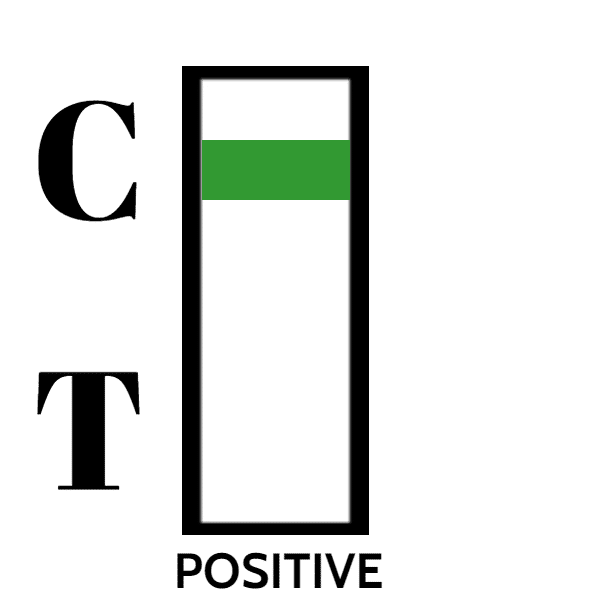
Only one colored band appears in the control region (C).
No apparent colored band appears in the test region (T)
Negative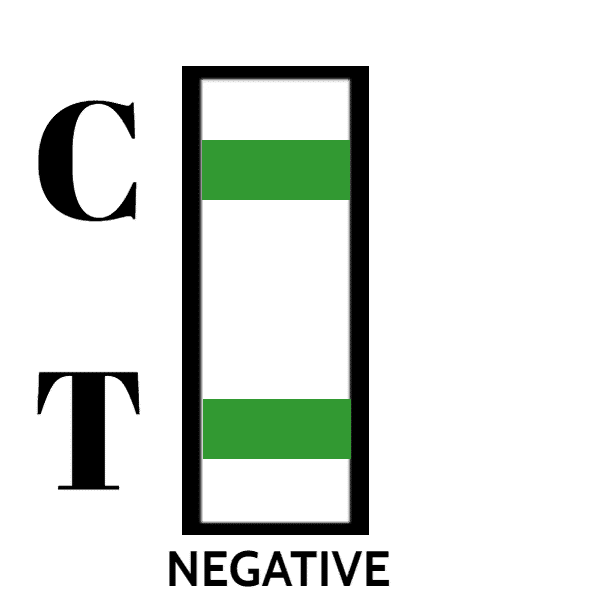
Two colored bands appear on the membrane.
One band appears in the control regions (C), and another in the test region(T).
Invalid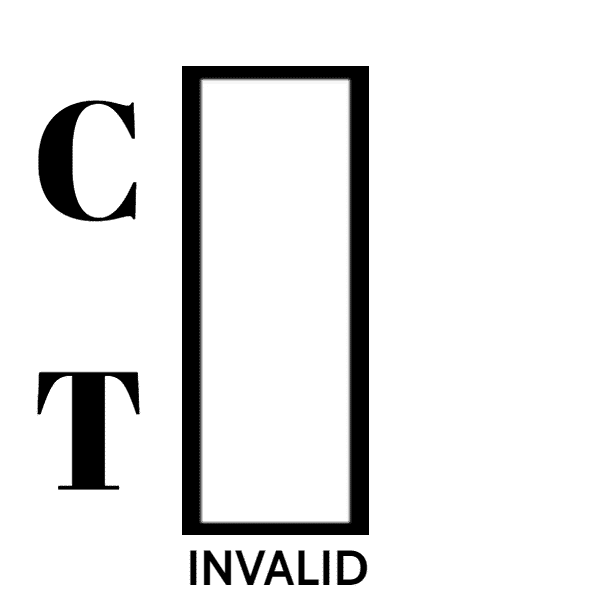
Any result without a control band at the specified read time must be disregarded.
Retest the procedure. If the problem persists, discontinue using the kit and contact your local distributor.
All our products ship on the same day if ordered Monday – Friday by 3:00 pm EST

- USPS and FED EX Ground & Expedited Services are subject to delays due to labor challenges.
- FED EX will not deliver to PO Boxes, and there are No Saturday or Sunday deliveries.
- FED EX OVERNIGHT is delivered the next ‘business day’, only if your order is placed before 3:00PM EST.
- FRIDAY OVERNIGHT orders are delivered on Monday and do not include holidays.
If you ordered through USPS, your label may not appear in their system for up to three days after they receive the package. The same thing can happen with FED Ex orders, despite the fact that they almost always appear in their system the night before they are dispatched. Please contact us if you have any queries about the progress of your order, and we will look into it.FED EX uses 'business' days (Monday-Friday) for making air deliveries, so you'll get your package the next 'business' day after it's been shipped. Orders placed after 3:00 p.m. EST are not shipped the same day, therefore Next Day orders placed after 3:00 p.m. will be shipped the next business day.Within one business day of placing your order, you will receive an email with your tracking number. It's possible that you didn't receive this email because it was entered improperly, forwarded to your spam folder, or was blocked. If you have not received this email, please contact us by phone or email and we will gladly update you on the progress of your shipment.Returns for unused items are accepted as long as they are placed within 30 days of the purchase date. If the shipping is free at the time of order, we will incur a cost for each order that is dispatched, and you will be repaid the value of your order once we receive the returned goods, minus the shipping costs.
| Status | Forensic Use Only |
|---|---|
| Drugs Tested | Amphetamine (AMP), Barbiturates (BAR), Benzodiazepines (BZO), Buprenorphine (BUP), Cocaine (COC), Ecstasy (MDMA), Ethyl-glucuronide (EtG), Fentanyl (FYL), Marijuana (THC), Methadone (MTD), Methamphetamine (MET), Opiates (OPI/MOR), Oxycodone (OXY), Phencyclidine (PCP), Gabapentin (GAB) |
CUT OFF LEVELS:
| Drug Name | Abbreviation | Detection time | Cut-Off Level |
| Amphetamines |
AMP |
1-2 Days | 1000 ng/mL |
| Barbiturates |
BAR |
1-2 Days | 300 ng/mL |
| Benzodiazepines |
BZO |
1-2 Days | 300 ng/mL |
| Buprenorphine |
BUP |
2-6 Days | 10 ng/mL |
| Cocaine |
COC |
2-4 Days | 300 ng/mL |
| Ecstasy |
MDMA |
2-4 Days | 500 ng/mL |
| Ethyl-glucuronide |
ETG |
3 Days | 300 ng/mL |
| Fentanyl |
FYL |
2-3 Days | 20 ng/mL |
| Marijuana |
THC |
5+ Days | 50 ng/mL |
| Methadone |
MTD |
1-3 Days | 300 ng/mL |
| Methamphetamine |
MET |
2-4 Days | 1000 ng/mL |
| Opiates/Morphine |
OPI |
2-3 Days | 300 ng/mL |
| Oxycodone |
OXY |
1-3 Days | 100 ng/mL |
| Phencyclidine |
PCP |
7-14 Days | 25 ng/mL |
| Gabapentin |
GAB |
1-4 Days | 1000 ng/mL |
What is Forensic use only?
Forensic Use Only devices are meant to be sold for research purposes only. The FDA does not regulate these devices, and they are solely to be used as screening instruments. Please send the device to a laboratory for confirmation if more information about the results of a forensic use-only drug test is needed.
Courts, police departments, probation/parole offices, juvenile detention centers, prisons, jails, correction centers, and other law enforcement organizations, as well as laboratories or other establishments that provide forensic testing for these institutions, are all eligible users.
Forensic Applications Only gadgets are not designed, tested, manufactured, or labeled for use in other settings such as clinical diagnostics or the workplace.
What does it mean when something says “For Forensic Use Only”?
This indicates that the drug-testing gadget has not received FDA 510k approval. This type of drug test should not be used for job screening, pain management screening, or any other reason. These tests are only used in law enforcement, prisons, the military, and other government institutions to test for drugs.
What products are included in this category?
Some saliva/oral drug detection products are only meant to be used in forensic situations. Furthermore, some specialty tests (such as our K2/Spice drug test) are designed exclusively for forensic use. This category could include other screening equipment. The product page will explicitly list any forensic-only equipment on our site.
MORE INFO: 15 Panel Drug Test Cup
What is a 15 Panel Drug Test?
A 15 panel drug test is one of the most comprehensive forms of drug screening available today. This test screens for the presence of 15 different types of drugs, ranging from common illicit substances to specific prescription medications. Unlike a standard 5 or 10-panel test, the 15 panel goes the extra mile, offering more detailed insights into an individual’s recent drug use.
Typically administered through a urine sample, this test has become a go-to solution for employers, medical facilities, and legal entities looking for a thorough understanding of a person’s drug history. In fact, many organizations are now upgrading from lower panel counts to 15-panel testing due to the increasing abuse of synthetic and prescription drugs.
The test can detect drugs consumed within the last few days or even weeks, depending on the substance and the individual’s metabolism. With growing concerns around workplace safety, drug compliance in medical programs, and legal monitoring, the 15 panel test has established itself as a powerful tool in modern drug detection strategies.
So, whether you’re an employer looking to maintain a drug-free workplace or a person preparing for such a test, understanding what it entails is crucial.
Why is it Used?
The 15 panel drug test isn’t just about catching drug users—it’s about creating safer, more responsible environments. It’s primarily used by employers, especially those in safety-sensitive industries like transportation, construction, and healthcare. For these roles, even one instance of impaired judgment can lead to disaster, and this test helps prevent that.
But it doesn’t stop there. Courts and probation officers also rely on this comprehensive test to ensure individuals are complying with terms of release or rehabilitation. If someone has a history of substance abuse, regular 15 panel testing helps track their progress and keeps them accountable.
In the medical and mental health world, the test is often used to confirm whether patients are taking prescribed medications correctly—or misusing them. Doctors can use these results to adjust treatment plans, or in some cases, intervene with detox or rehab recommendations.
Furthermore, the rise in opioid abuse and misuse of medications like Gabapentin and Fentanyl has made the 15 panel test more relevant than ever. It helps detect not just illegal street drugs but also prescription medications that are often abused.
In short, the test is used where precision, accountability, and safety are non-negotiable. It offers a holistic look at someone’s drug use, making it invaluable for multiple industries and purposes.
What Drugs Are Detected in a 15 Panel Drug Test?
Breakdown of All 15 Substances
When it comes to thorough drug screening, the 15 panel drug test is the gold standard. Here’s what you can expect to be tested for:
- Amphetamines
- Barbiturates
- Benzodiazepines
- Buprenorphine
- Cannabinoids (THC)
- Cocaine
- Ecstasy (MDMA)
- Fentanyl
- Gabapentin
- Methadone
- Methamphetamines
- Opiates
- Oxycodone
- Phencyclidine (PCP)
- Ethyl-glucuronide (EtG)
Each substance on this list carries its own risks and side effects. Some, like amphetamines and benzodiazepines, are commonly prescribed medications. Others, like PCP and cocaine, are illegal recreational drugs. By screening for this wide range, the 15 panel test catches a mix of legal and illicit substances that can impair performance or indicate abuse.
This test is particularly effective because it includes newer drugs like Gabapentin and Fentanyl, which are often missed by older drug screening panels. Both of these substances are prescribed but widely misused—making their inclusion critical in today’s drug monitoring landscape.
So, whether someone is abusing pain meds or taking illegal party drugs, this test can reveal the truth in just one urine sample.
Common Prescription and Illicit Drugs Included
It’s important to understand that not all drugs tested in a 15 panel are illegal. Some are prescription medications, legally obtained and used for valid health issues. However, misuse or abuse of these drugs can still trigger a failed drug test.
Prescription drugs commonly included:
- Gabapentin: Prescribed for nerve pain but often misused for its euphoric effects.
- Fentanyl: A powerful opioid painkiller, extremely addictive and dangerous.
- Oxycodone and Methadone: Prescribed for pain management but have high abuse potential.
- Benzodiazepines: Used for anxiety and insomnia but highly addictive.
Illicit drugs often found:
- Cocaine and MDMA (Ecstasy): Party drugs with no medical use.
- PCP and Methamphetamines: Strong hallucinogens and stimulants.
- THC (Cannabis): Still illegal in many regions, especially in workplaces or federal jobs.
The inclusion of these drugs means the test doesn’t just focus on obvious illegal substances—it targets misuse across the board. That makes it a reliable screening method for nearly any scenario.
Types of 15 Panel Drug Tests
15 Panel Urine Drug Test
The most widely used form of the 15 panel test is the urine drug test. This method is preferred for its ease of use, affordability, and relatively long detection window for most drugs. Employers and institutions often choose urine tests because they are non-invasive, quick to process, and offer reliable results.
Here’s how it works: the individual provides a urine sample, usually under supervision to avoid tampering. The sample is then sent to a lab or tested on-site using immunoassay screening and confirmation methods such as GC/MS (Gas Chromatography/Mass Spectrometry) for accuracy.
Urine tests can detect drug use from several days up to a few weeks, depending on the substance and the individual’s metabolism. For example, THC can linger for weeks in chronic users, while cocaine might only be detectable for a couple of days.
Pros:
- Cost-effective
- Easy to administer
- Long detection window for many drugs
Cons:
- Possible for tampering if unsupervised
- Less accurate for very recent drug use (within hours)
This test is standard across workplaces, probation departments, and healthcare settings. If you’re getting a drug test, chances are it’s a urine-based one.
15 Panel Drug Test Gabapentin Cup
The 15 panel drug test with Gabapentin inclusion has become increasingly popular due to the rise in off-label use and abuse of this prescription medication. Gabapentin, originally designed to treat seizures and nerve pain, is not a controlled substance in many states—but that doesn’t mean it’s harmless. Many individuals misuse it for its calming, euphoric effects or to enhance the high of other drugs, especially opioids.
The Gabapentin Cup is a urine testing device specially formulated to detect this specific drug. Unlike some earlier panels that would miss Gabapentin entirely, this version includes it alongside the standard 14 substances. This is a game-changer for employers and clinics dealing with individuals who might be prescribed Gabapentin or at risk of abusing it.
The test works just like any urine cup test: the person urinates into the cup, and within minutes, the cup displays results with colored lines indicating whether the drug is present. The simplicity and speed make it ideal for on-the-spot testing without lab delays.
Here’s why this version matters:
- Gabapentin misuse is rising among both youth and chronic pain patients.
- Non-detection in earlier drug panels left a gap in monitoring efforts.
- Rehabilitation centers now require this version to track Gabapentin misuse.
Incorporating Gabapentin testing helps create a more comprehensive picture of a person’s drug use, ensuring no dangerous substances go unnoticed—even if they’re technically legal.
15 Panel Drug Test Fentanyl Cup
Fentanyl, a synthetic opioid that’s 50-100 times stronger than morphine, has become a major health crisis in recent years. It’s often laced into other drugs like heroin or counterfeit pills, leading to a surge in fatal overdoses. Because of this, many organizations have demanded a more advanced drug testing solution—and the 15 panel drug test Fentanyl cup answers that call.
This test is vital in settings like:
- Addiction treatment centers
- Hospitals and pain management clinics
- Probation offices and correctional facilities
- Workplaces in high-risk industries
The Fentanyl Cup includes detection for all the traditional drugs (THC, cocaine, meth, etc.) along with a dedicated strip that specifically screens for Fentanyl. What makes this so critical is that even trace amounts of Fentanyl can cause life-threatening respiratory depression—especially in someone who’s not opioid-tolerant.
These cups are CLIA-waived, meaning they are approved for professional use without lab certification, and deliver results in minutes. They can identify Fentanyl use up to 72 hours after consumption, sometimes longer in chronic users.
If you’re in a situation where Fentanyl might be a concern—either personally or professionally—this specialized 15 panel test is one of the most effective tools available.
How Does a 15 Panel Drug Test Work?
Collection Process
The process behind a 15 panel drug test is fairly straightforward, yet it’s conducted under strict protocols to ensure integrity. Whether it’s administered in a medical clinic, a workplace, or a rehab center, the collection process is designed to minimize the chance of sample tampering or contamination.
Here’s how the process typically works:
- Preparation: The individual is asked to empty their pockets and may be given a hospital gown or similar attire to prevent hiding synthetic urine or tampering tools.
- Collection Site: Supervised or semi-supervised collection occurs in a designated bathroom that may have features like blue toilet water or water shut-off valves to prevent dilution.
- Urine Sample: A sample of at least 30-45 mL is collected in a sterile cup. The temperature of the sample is immediately tested to ensure it’s in the expected range (90°F–100°F), confirming it’s fresh and genuine.
- Sealing and Labeling: The cup is sealed with tamper-evident tape, labeled, and accompanied by a Chain of Custody form if it’s going to a lab.
- Testing: The sample is either tested on the spot using a multi-panel cup or sent to a laboratory for confirmatory testing using techniques like Gas Chromatography-Mass Spectrometry (GC-MS) or Liquid Chromatography-Tandem Mass Spectrometry (LC-MS/MS).
Every step is documented meticulously to avoid any possibility of misidentification or manipulation. For workplaces and legal testing, following these procedures is often mandatory.
Testing and Analysis Methods
Once the sample is collected, it’s time for the science to take over. The analysis phase involves two levels of testing:
- Initial Screening – This is typically an immunoassay that detects the presence of drug metabolites. It’s fast and cost-effective, providing results in a matter of minutes when using dip tests or cups.
- Confirmatory Testing – If the screening returns a positive result, a second, more precise method is employed. This is where GC-MS or LC-MS/MS comes into play, which can accurately quantify the exact amount of a substance and confirm its presence.
Here’s a quick breakdown of each method:
| Method | Use Case | Turnaround Time | Accuracy |
|---|---|---|---|
| Immunoassay | Initial screen | Immediate (minutes) | Moderate |
| GC-MS | Confirm positives | 24-72 hours | High |
| LC-MS/MS | Complex cases | 24-72 hours | Very High |
Testing labs are also capable of identifying false positives, which can happen if someone is taking over-the-counter meds that mimic drug metabolites. That’s why confirmatory testing is vital—it helps avoid incorrect accusations or decisions.
With these rigorous methods, the 15 panel test offers unparalleled accuracy in detecting a wide range of drug use, from a single-time user to someone with a prolonged pattern.
Who Typically Uses the 15 Panel Drug Test?
Employers and Workplace Testing
One of the most common users of the 15 panel drug test is the business world—especially companies that prioritize safety, reliability, and productivity. Employers in industries such as construction, transportation, healthcare, manufacturing, and law enforcement often implement routine drug testing to ensure that employees are not under the influence of harmful substances.
This test isn’t just about enforcing rules; it’s about protecting lives. In fields like truck driving or construction, a single impaired worker can cause catastrophic accidents. That’s why many companies require drug screening before hiring, as well as random tests during employment. Post-accident testing is also standard protocol in many firms.
With the 15 panel test’s ability to detect a broader range of drugs—including prescription medications that are often abused—it’s an ideal choice for modern workplace policies. Many employers are now updating their old 5-panel tests to the more thorough 15-panel version to match the evolving drug landscape.
It’s also worth noting that these tests help businesses:
- Avoid legal liability from workplace accidents
- Comply with federal regulations (especially in DOT-covered jobs)
- Foster a drug-free environment, improving morale and performance
So if you’re heading into a job interview or returning from medical leave, there’s a strong chance this test will be part of the process.
Legal and Probation Requirements
Drug testing plays a critical role in the legal system, especially for individuals on probation, parole, or those involved in custody disputes and court-ordered treatment programs. The 15 panel drug test has become a go-to solution for courts and correctional agencies that require reliable, comprehensive monitoring of drug use.
For individuals under court supervision, regular drug testing is often a condition of:
- Probation or parole
- Child custody evaluations
- Diversion programs (like drug court)
- Rehabilitation or substance abuse counseling
The courts rely on this test because of its ability to catch not just the usual suspects like marijuana or cocaine, but also commonly abused prescriptions like Tramadol, Gabapentin, and Benzos—drugs that could otherwise fly under the radar.
In many legal situations, a failed drug test could lead to:
- Re-arrest or jail time
- Loss of child custody or visitation
- Extension or modification of probation terms
Because the stakes are high, confirmatory testing using lab analysis is almost always included in legal contexts. Additionally, the chain-of-custody protocols are strictly followed to ensure that test results can hold up in court.
This type of test gives courts the assurance they need to enforce rulings fairly, while also giving individuals a clear path toward demonstrating compliance and progress.
Medical and Rehab Centers
Medical professionals and addiction recovery centers also rely heavily on the 15 panel drug test. In clinical environments, it’s crucial to understand a patient’s complete drug history to offer safe and effective treatment.
Doctors, especially those in pain management or psychiatry, may use the test to:
- Ensure patients are taking prescribed meds appropriately
- Detect non-prescribed or harmful drug use
- Avoid prescribing drugs that could interact dangerously with substances already in the patient’s system
In rehab and detox centers, the test is used upon admission and throughout the treatment process. This ensures:
- Patients are detoxing properly
- No drugs are being snuck into the facility
- Recovery progress is being monitored closely
What sets this test apart in these settings is the inclusion of medications like Buprenorphine, Methadone, and Fentanyl, which are often part of medication-assisted treatment (MAT). The 15 panel test helps verify whether these meds are being used as prescribed or misused.
In short, this test is more than a diagnostic tool—it’s a therapeutic checkpoint that aids healthcare providers in making life-saving decisions and improving long-term outcomes for their patients.
How to Pass a 15 Panel Drug Test
Let’s be real—many people search this topic because they’re worried about failing. Whether you’ve taken something legally prescribed or partied a little too hard last weekend, passing a drug test can feel stressful. But here’s the truth: the only guaranteed way to pass is to not have drugs in your system.
That said, there are some practical, legal steps you can take to improve your odds:
1. Know What You’re Taking
- Even prescription medications can cause a failed test.
- Make a list of everything you’re taking and inform the test administrator in advance.
2. Time It Right
- Most drugs leave your system within 3–10 days, though some like THC can stay for up to a month.
- If possible, schedule your test after a clean period to minimize risks.
3. Hydrate and Eat Well
- Drinking water won’t “flush” your system completely, but staying hydrated can help.
- A healthy diet supports liver function, which helps detox naturally.
4. Avoid Detox Myths
- Products that claim to “cleanse” your system often don’t work and may be flagged.
- Some detox drinks temporarily mask drugs, but sophisticated labs can detect this tampering.
5. Be Honest
- If you’re taking a prescribed medication that may show up on the test (like Gabapentin, Buprenorphine, or Oxycodone), bring documentation.
- Most employers and legal bodies consider prescribed use legitimate—unless the medication is being misused.
- Trying to cheat a drug test is risky, especially for legal or employment-related screenings. The best strategy is to stay clean, know your meds, and be upfront about anything that might pop up.
Order from Ovus Medical Today!
The 15 panel drug test is more than just a screening tool—it’s a comprehensive safety net in today’s increasingly complex landscape of substance use and abuse. From the workplace to the courtroom and into the healthcare system, this test offers an all-encompassing view of a person’s recent drug history, catching substances that might otherwise fly under the radar.
Its ability to detect both illicit street drugs and widely abused prescription medications makes it indispensable for employers, legal professionals, and medical providers alike. Whether you’re preparing for a test, implementing a screening program, or just curious about how it works, understanding the ins and outs of the 15 panel drug test puts you one step ahead.
As drug use patterns evolve, so must our testing methods. And the 15 panel test rises to that challenge—offering depth, precision, and peace of mind in high-stakes environments.
FAQs
1. How long do drugs stay detectable in a 15 panel urine test?
Detection times vary by substance. For example, marijuana can stay in the system for up to 30 days in heavy users, while cocaine is usually detectable for 2–4 days. Prescription drugs like Gabapentin may linger for several days as well.
2. Can I take a 15 panel drug test at home?
Yes, there are at-home versions of the 15 panel drug test available online and at pharmacies. However, results are preliminary and may need confirmation from a lab for official use.
3. Will prescription medications cause a failed test?
If you’re taking a legally prescribed drug that appears on the panel, it will show up—but you won’t “fail” if you disclose your prescription ahead of time and provide documentation.
4. How accurate is the 15 panel drug test?
Very accurate, especially when followed by confirmatory lab testing (like GC-MS). Instant test cups provide fast results, but lab analysis ensures precision and rules out false positives.
5. How can someone prepare for a 15 panel drug test?
The best preparation is abstinence from all non-prescribed drugs. Drinking lots of water won’t “flush” your system effectively and may dilute your sample, which can raise red flags.
Place Your Order Today!
You may also like…
-
20 Panel Drug Test Cup with GAB, FYL & ADLTX
As Low As $3.19
Forensic Use Only
$3.99 Info & Price This product has multiple variants. The options may be chosen on the product page -
The Mega 28 Panel Drug Test Cup
As Low As $4.29
Forensic Use Only
$5.09 Info & Price This product has multiple variants. The options may be chosen on the product page -
17 Panel Dip Card, Gabapentin, FEN, ETG, KRA
As Low As $2.35
Forensic Use Only
$2.29 Info & Price This product has multiple variants. The options may be chosen on the product page

